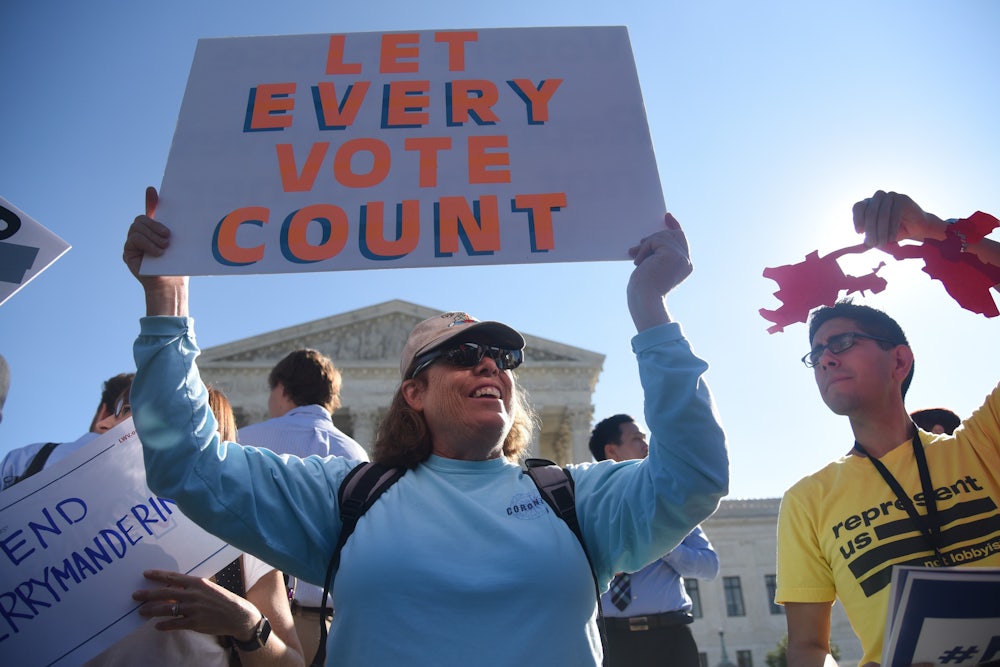In a move worthy of Ray Guy, the Supreme Court on Monday kicked two major redistricting cases back to the lower courts on procedural grounds. Many observers expected the justices to either use Gill v. Whitford and Benisek v. Lamone to establish a clear remedy for warped legislative districts, or declare it beyond the court’s power to fix; but the court left that fight for another day.
In doing so, the justices left open the chance to revisit the matter in the future; the court could still establish a standard by which the judiciary can reverse undemocratic partisan gerrymanders at a later term. That’s better than an outright defeat for voting-rights advocates, who feared the court might instead decide that the question was beyond the justices’ capacity to solve.
In Gill, the court heard a challenge to Wisconsin’s Republican-drawn map for its state legislative districts. A three-judge panel ruled in 2016 that the map violated a group of Wisconsin voters’ First and Fourteenth Amendment rights by tilting the districts to overwhelmingly favor Republicans. The party captured 60 of the State Assembly’s 99 seats with only 47 percent of the statewide vote in 2012, for example.
The court has never struck down a partisan gerrymander, nor has it articulated the legal grounds on which it might do so. In its unanimous opinion in Gill, the court again avoided answering that question. Instead, the justices ruled that the Wisconsin voters who brought the case hadn’t properly established their legal standing to obtain a remedy from the court, whatever that remedy may or may not be.
Chief Justice John Roberts, writing for the court, said that it was not enough for the plaintiffs to show a collective harm to Wisconsin Democrats, as they had argued in the lower courts. Instead, he said, the voters must first establish that their votes were diluted on an individual basis. “The plaintiffs did not seek to show such requisite harm since, on this record, it appears that not a single plaintiff sought to prove that he or she lives in a cracked or packed district,” he wrote.
Justice Elena Kagan wrote a separate concurrence for herself and the court’s other three liberal justices. In it, she nudged the plaintiffs on how they could reformulate their argument when the case returned to the lower courts. “The key point is that the case could go forward in much the same way it did below: Given the charges of statewide packing and cracking, affecting a slew of districts and residents, the challengers could make use of statewide evidence and seek a statewide remedy,” she wrote.
To underscore her stance, Kagan also took the opportunity to note that partisan gerrymandering threatened the fabric of American representative government:
More effectively every day, that practice enables politicians to entrench themselves in power against the people’s will. And only the courts can do anything to remedy the problem, because gerrymanders benefit those who control the political branches. None of those facts gives judges any excuse to disregard Article III’s demands. The Court is right to say they were not met here. But partisan gerrymandering injures enough individuals and organizations in enough concrete ways to ensure that standing requirements, properly applied, will not often or long prevent courts from reaching the merits of cases like this one. Or from insisting, when they do, that partisan officials stop degrading the nation’s democracy.
Where Gill addressed Republican manipulation of state legislative maps, Benisek instead focused on a Democratic gerrymander of a federal congressional district. Maryland Republicans argued that the state legislature’s 2011 revision of the sixth congressional district unfairly diluted their voting power in the district, which swung to Democratic control. A federal district court declined to issue a preliminary injunction in 2016 and stayed further proceedings until the Supreme Court’s ruling in Gill.
The Benisek plaintiffs asked the justices to intervene and compel the lower court to act. Here, too, the court had an opportunity to lay down a marker on partisan gerrymandering. Instead, the justices issued a short, unsigned opinion ruling that the lower court hadn’t abused its discretion by refusing to grant a preliminary injunction, especially while the court mulled a ruling in Gill. “Such a determination was within the sound discretion of the District Court,” the Supreme Court said.
The court hasn’t yet announced a decision in Abbott v. Perez, the third and final redistricting-related case on its docket this term. The complex seven-year legal battle focuses on how states use race to redraw their legislative maps after the decennial census. A group of black and Hispanic Texas voters argue that the state’s current legislative districts draw too heavily upon a 2011 map that courts later tossed out for violating the federal Voting Rights Act of 1965. Texas lawmakers contend that the current map can’t be unconstitutional because it’s virtually identical to an interim version of the 2011 map that a judge approved for use in the 2012 elections. The plaintiffs counter that lawmakers are effectively laundering the 2011 map’s discriminatory effects through the interim version.
Monday’s rulings leave open the possibility of future reform, though they can’t be considered a victory for foes of partisan gerrymandering. Warped legislative maps short-circuit the nation’s democratic process by creating legislatures that don’t quite reflect the voters’ collective will. Insulating lawmakers from popular discontent is ultimately damaging to American self-government. The Supreme Court is uniquely positioned to remedy this problem, and as long as it declines to do so, the damage only grows.
